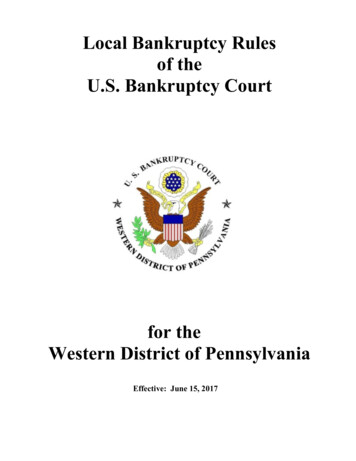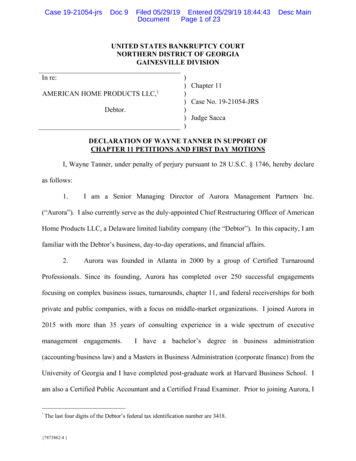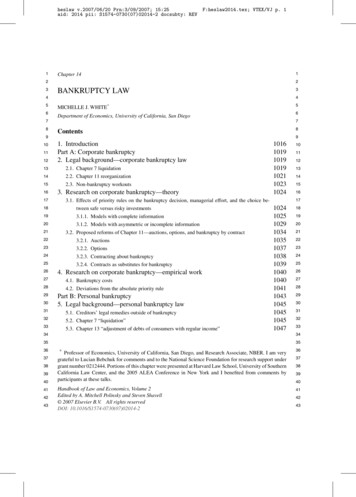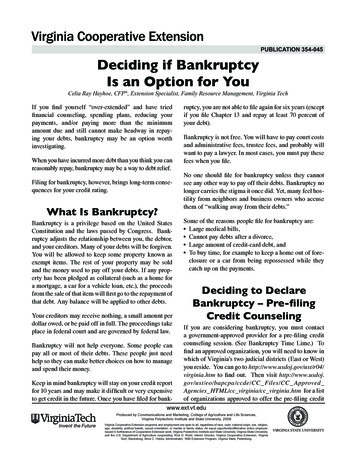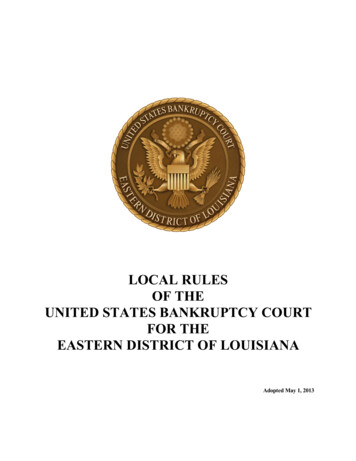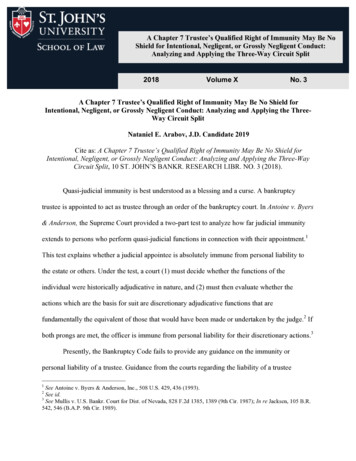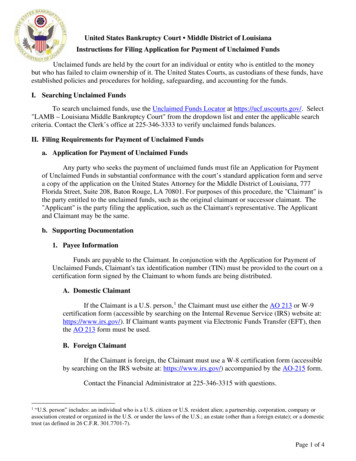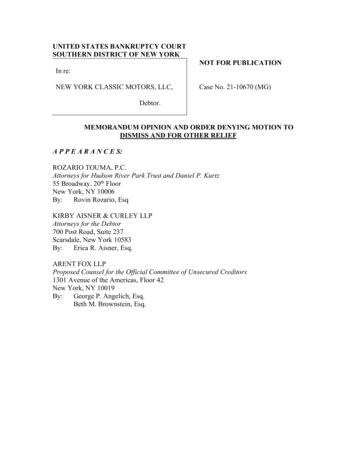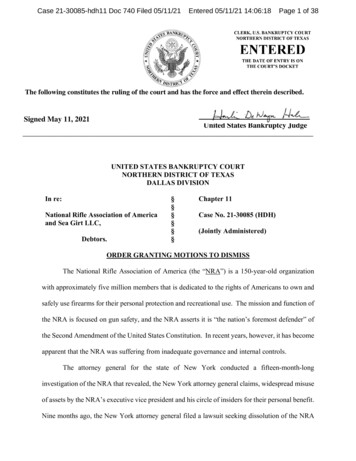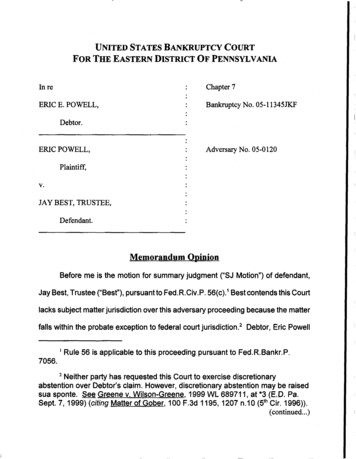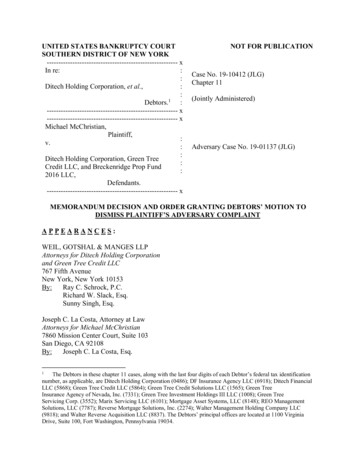
Transcription
UNITED STATES BANKRUPTCY COURTSOUTHERN DISTRICT OF NEW ---------- xIn re:::Ditech Holding Corporation, et al.,::Debtors.1 ------- ------- xMichael McChristian,Plaintiff,:v.::Ditech Holding Corporation, Green Tree:Credit LLC, and Breckenridge Prop Fund:2016 --------------------- xNOT FOR PUBLICATIONCase No. 19-10412 (JLG)Chapter 11(Jointly Administered)Adversary Case No. 19-01137 (JLG)MEMORANDUM DECISION AND ORDER GRANTING DEBTORS’ MOTION TODISMISS PLAINTIFF’S ADVERSARY COMPLAINTAPPEARANCES:WEIL, GOTSHAL & MANGES LLPAttorneys for Ditech Holding Corporationand Green Tree Credit LLC767 Fifth AvenueNew York, New York 10153By:Ray C. Schrock, P.C.Richard W. Slack, Esq.Sunny Singh, Esq.Joseph C. La Costa, Attorney at LawAttorneys for Michael McChristian7860 Mission Center Court, Suite 103San Diego, CA 92108By:Joseph C. La Costa, Esq.1The Debtors in these chapter 11 cases, along with the last four digits of each Debtor’s federal tax identificationnumber, as applicable, are Ditech Holding Corporation (0486); DF Insurance Agency LLC (6918); Ditech FinancialLLC (5868); Green Tree Credit LLC (5864); Green Tree Credit Solutions LLC (1565); Green TreeInsurance Agency of Nevada, Inc. (7331); Green Tree Investment Holdings III LLC (1008); Green TreeServicing Corp. (3552); Marix Servicing LLC (6101); Mortgage Asset Systems, LLC (8148); REO ManagementSolutions, LLC (7787); Reverse Mortgage Solutions, Inc. (2274); Walter Management Holding Company LLC(9818); and Walter Reverse Acquisition LLC (8837). The Debtors’ principal offices are located at 1100 VirginiaDrive, Suite 100, Fort Washington, Pennsylvania 19034.
HON. JAMES L. GARRITY, JR.U.S. BANKRUPTCY JUDGEIntroduction2In 2005, Michael McChristian (the “Plaintiff”) purchased the premises located at 11118Ironwood Drive, San Diego, California (the “Property”). He financed the acquisition with a loanfrom Homecoming Financial Network Inc. (“Homecomings”). In that transaction, the Plaintiffexecuted a promissory note (the “Note”) and a deed of trust (the “Deed of Trust”) to securepayment of the Note. Green Tree Servicing LLC (“Green Tree”) is the assignee of the Deed ofTrust.3 In January 2019, Clear Recon Corp., as trustee under the Deed of Trust, sold the Propertyto Breckenridge Property Fund 2016 LLC (“Breckenridge”) at a nonjudicial foreclosure sale.Breckenridge subsequently sued the Plaintiff in the California Superior Court to evict him fromthe Property. The Plaintiff resolved that litigation by stipulating to the entry of judgement by thestate court in favor of Breckenridge which, without limitation, vested Breckenridge with title tothe Property, and pursuant to which he surrendered possession of the Property to Breckenridge.In this adversary proceeding, the Plaintiff is suing Green Tree, Ditech HoldingCorporation Mortgage, LLC (“Ditech,” with Green Tree, the “Ditech Defendants”) andBreckenridge (with the Ditech Defendants, the “Defendants”), to unwind the foreclosure sale onthe grounds that the assignments of the Deed of Trust were defective and, as such, the sellerlacked authority to sell the Property. He also seeks damages from the Ditech Defendants2Capitalized terms used but not otherwise defined in the Introduction shall have the meanings ascribed to themherein. References herein to “ECF No. ” are to documents filed in the electronic docket in these jointlyadministered cases In re Ditech, Case No. 19-10412 (the “Chapter 11 Cases”). References to documents filed in thisadversary case, Michael McChristian v. Ditech Holding Corporation, et. al, Adversary Case No. 19-01137, shall becited as “[AP ECF No. ]”.3Green Tree Credit LLC is named as a defendant in the Complaint, but the Corporate Assignment of Deed ofTrust, annexed as Exhibit C to the Slack Declaration, names Green Tree Servicing LLC as the assignee of the Deedof Trust. The Court understands that the Plaintiff is suing Green Tree Servicing LLC.2
occasioned by their alleged negligence and bad acts prior to the foreclosure sale in servicing theNote. The Plaintiff, through his counsel of record, filed a proof of claim in these Chapter 11Cases which, as amended, seeks 5 million in damages based on “Litigation.” One or both of theDitech Defendants are named defendants in each of the nine counts alleged in support of theComplaint. Two of the counts seek monetary damages; the remaining counts seek different formsof equitable relief.The matter before the Court is the Ditech Defendants’ motion pursuant to Rule 12(b)(6)of the Federal Rules of Civil Procedure (“Rule 12(b)(6)”)4 to dismiss the Complaint, withprejudice (the “Motion”).5 In support of the Motion, the Ditech Defendants assert that theComplaint is procedurally improper because claims for money damages for prepetition conductare properly brought through the bankruptcy claims resolution process in these Chapter 11 Cases,not in an adversary proceeding. They maintain that since the Plaintiff has filed a 5 million proofof claim based on “Litigation,” which he filed simultaneously with the commencement of thisadversary proceeding, he has acknowledged that all the claims at issue in the Complaint, can bereduced to a monetary judgment and, as such, the Court should dismiss the Complaint, in favorof the claims resolution process. They also contend that the claims that Plaintiff purports to assertin the Complaint are barred by application of the doctrines of res judicata and judicial estoppel.The Plaintiff opposes the Motion.64Rule 12(b)(6) is made applicable herein by Rule 7012 of the Federal Rules of Bankruptcy Procedure (the“Bankruptcy Rules”).5See Debtors’ Motion to Dismiss Plaintiff’s Adversary Complaint [AP ECF No. 12]. See also Declaration ofRichard W. Slack in Support of Debtors’ Motion to Dismiss Plaintiff’s Adversary Complaint [AP ECF No. 12-1](the “Slack Declaration”).6See 1) Plaintiff’s Opposition to Defendant Ditech Holding Corporation Mortgage, Green Tree Credit LLCMotion to Dismiss the Complaint; 2) Plaintiff’s Motion for Permission to File an Amended Complaint [AP ECF No.18] (the “Opposition”).3
For the reasons set forth herein, the Court grants the Motion and dismisses the Complaint,with prejudice.JurisdictionThe Court has jurisdiction to consider this matter pursuant to 28 U.S.C. §§ 157 and 1334and the Amended Standing Order of Reference dated January 31, 2012 (Preska, C.J.). This is acore proceeding pursuant to 28 U.S.C. § 157(b).Background7On February 18, 2005, Plaintiff executed the Note in the amount of 326,000.00 tofinance the purchase of the Property. As security for the Note, the Plaintiff executed the Deed ofTrust which was recorded with the County of San Diego on February 28, 2005. See Deed ofTrust.8 The Deed of Trust identified Homecomings as the lender and Mortgage ElectronicRegistration Systems, Inc. (“MERs”) as nominee for the lender and beneficiary of the Deed ofTrust. See id. Pursuant to an assignment recorded on September 17, 2010, MERs assigned itsbeneficial interest in the Deed of Trust to GMAC Mortgage, LLC (“GMAC”). See Assignment7The purpose of a Rule 12(b)(6) motion is to test the legal sufficiency of a complaint. Accordingly, the factsrecited herein are those alleged in the Complaint, which the Court presumes to be true in resolving this Motion. SeeAshcroft v. Iqbal, 556 U.S. 662, 678 (2009); see also Roth v. Jennings, 489 F.3d 499, 509 (2d Cir. 2007) (“In anyevent, a ruling on a motion for dismissal pursuant to Rule 12(b)(6) is not an occasion for the court to make findingsof fact.”). In resolving a motion to dismiss, the Court is “free to consider documents that are incorporated into thecomplaint by reference or attached to the complaint as exhibits, or whose terms and effect are relied upon by theplaintiff in drafting the complaint.” Gryl ex rel. Shire Pharmaceuticals Group PLC v. Shire Pharmaceuticals GroupPLC, 298 F.3d 136, 140 (2d Cir. 2002). See also Chambers v. Time Warner, Inc., 282 F.3d 147, 152–54 (2d Cir.2002) (“For purposes of this rule, ‘the complaint is deemed to include any written instrument attached to it as anexhibit or any statements or documents incorporated in it by reference.’”) (citation omitted); In re Spiegel, Inc., 337B.R. 821, 824 (Bankr. S.D.N.Y. 2006) (“Documents whose terms and effect are relied upon by the plaintiff indrafting the complaint may be considered on a motion to dismiss, even if the documents are not submitted asexhibits by the plaintiff.”) Moreover, when evaluating the adequacy of a complaint, a court may also considerexhibits that are subject to judicial notice, without converting a motion to dismiss into a motion for summaryjudgment. Lee v. City of Los Angeles, 250 F.3d 668, 689 (9th Cir. 2001). A court may take judicial notice of “mattersof public record.” Mack v. S. Bay Beer Distributors, Inc., 798 F.2d 1279, 1282 (9th Cir. 1986). In reviewing thefacts relevant to the Motion, the Court will take judicial notice of the documents in the exhibits annexed to the SlackDeclaration.8A copy of the Deed of Trust is annexed as Exhibit A to the Slack Declaration.4
of Deed of Trust.9 In turn, on February 16, 2015, GMAC assigned the Deed of Trust to GreenTree. See Corporate Assignment of Deed of Trust.10In 2011, the Plaintiff filed for bankruptcy. Compl. ¶ 17. In October 2012, the Plaintiffwas approved for a loan modification with GMAC. See id. ¶ 19. However, in January 2013,GMAC notified the Plaintiff that his loan and mortgage had been transferred to Green Tree. Seeid. ¶ 20. Over the next several months, the Plaintiff had multiple communications with variousrepresentatives at Green Tree concerning the loan modification, account statements, and thetransfer of his loan from GMAC to Green Tree. See id. ¶¶ 21-32. In or about June 2013, thePlaintiff received notification from Green Tree that his loan modification was approved andfinalized. See id. ¶ 33.The Plaintiff contends that beginning in December 2013 and continuing to December2014, he received notices of past due payments and notices of default from Green Tree whichwere erroneous, as well as an offer to enter into another loan modification. See id. ¶¶ 38-59. Heasserts that beginning in January 2015 and into 2017, he received notices that his loan was indefault and the Property was going into foreclosure. See id. ¶¶ 60-73. See also Notice of Defaultrecorded Nov. 29, 2016.11 The Plaintiff does not dispute that he was in arrears under the Note butdisputes the amount claimed due and owing under the notices. See Compl. ¶ 75. By Notice ofTrustee Sale dated November 15, 2017, a foreclosure sale of the Property was scheduled forJanuary 5, 2018. See Notice of Trustee Sale;12 see also Compl. ¶ 74 (noting the sale wasscheduled for January 1, 2018).9A copy of the Assignment of Deed of Trust is annexed as Exhibit B to the Slack Declaration.10A copy of the Corporate Assignment of Deed of Trust is annexed as Exhibit C to the Slack Declaration.11A copy of the Notice of Default is annexed as Exhibit D to the Slack Declaration.12A copy of the Notice of Trustee Sale is annexed as Exhibit E to the Slack Declaration.5
In April 2018, to avoid foreclosure of the Property, the Plaintiff commenced a case underchapter 13 of the Bankruptcy Code in the United States Bankruptcy Court for the SouthernDistrict of California (the “Chapter 13 Case”). See Compl. ¶ 79. In support of that case, thePlaintiff filed Schedule A/B.13 In that schedule, the Plaintiff was asked to “Describe YourFinancial Assets,” and, in particular to state whether he “own[ed] or [had] any legal or equitableinterest” in (i) “[c]laims against third Parties, whether or not you have filed a lawsuit or made ademand for payment;” or (ii) “[o]ther contingent and unliquidated claims of every nature,including counterclaims of the debtor or any rights to setoff claims.” See Schedule A/B, Part 4 ¶¶33, 34. The Plaintiff responded “No” to both questions; he did not identify any claims againstGreen Tree or Ditech concerning his Note and mortgage, any claims, or rights to set off againstGreen Tree, or the proposed foreclosure sale of the Property. See id. The Plaintiff did notconfirm a plan in the Chapter 13 Case. On December 4, 2018, the bankruptcy court dismissed thecase without prejudice. See Compl. ¶ 80.After the court dismissed the Chapter 13 Case, Clear Recon Corp., as trustee under theDeed of Trust, sold the Property at a nonjudicial foreclosure sale (the “Foreclosure Sale”) toBreckenridge for the sum of 593,500.00. On January 15, 2019, the trustee, recorded a Trustee’sDeed Upon Sale to Breckenridge. See Trustee’s Deed Upon Sale.14 On January 23, 2019,Breckenridge commenced an unlawful detainer eviction action in the Superior Court for the Stateof California – San Diego County (the “California Superior Court”) against the Plaintiff fordamages and to obtain possession of the Property (the “Unlawful Detainer Action”). See13A copy of Schedule A/B filed in the Plaintiff’s Chapter 13 Case is annexed as Exhibit F to the SlackDeclaration.14A copy of the Trustee’s Deed Upon Sale is annexed as Exhibit G to the Slack Declaration.6
Complaint for Unlawful Detainer Action.15 In his answer to the Unlawful Detainer Action, thePlaintiff raised affirmative defenses, including that the trustee’s sale was invalid and did notconvey clear title to Breckenridge. See Answer - Unlawful Detainer Action ¶ 3.16 The Plaintiffand Breckenridge subsequently entered into a Stipulated Agreement for Judgment or Dismissalthe (“Stipulated Judgment”).17 Pursuant to the judgment, Plaintiff agreed to surrender possessionof the Property to Breckenridge at 3:00pm on July 8, 2019 and to pay a monetary judgment of 23,019.56 for sanctions in Breckenridge’s favor. Stipulated Judgment at 2. The parties agreedthat judgment for Breckenridge in the Unlawful Detainer Action “will be entered now.” Id. TheStipulated Judgment conclusively resolved the complaint filed in the Unlawful Detainer Actionin favor of Breckenridge.The Chapter 11 CasesOn February 11, 2019 (the “Petition Date”), Ditech Holding Corporation (f/k/a WalterInvestment Management Corp.) and certain of its affiliates (“Debtors”) filed petitions for reliefunder chapter 11 of the Bankruptcy Code in this Court. Thereafter, the Debtors remained inpossession and control of their business and assets as debtors in possession pursuant to sections1107(a) and 1108 of the Bankruptcy Code. On September 26, 2019, the Debtors confirmed theirThird Amended Plan, and on September 30, 2019, that plan became effective.1815A copy of the Complaint for Unlawful Detainer Action is annexed as Exhibit H to the Slack Declaration.16A copy of the Answer - Unlawful Detainer Action is also annexed as Exhibit H to the Slack Declaration.17A copy of the Stipulated Judgment is annexed as Exhibit J to the Slack Declaration.18See Third Amended Joint Chapter 11 Plan of Ditech Holding Corporation and its Affiliated Debtors [ECF No.1326]; Order Confirming Third Amended Joint Chapter 11 Plan of Ditech Holding Corporation and its AffiliatedDebtors [ECF No. 1404]. Notice of (I) Entry of Order Confirming Third Amended Joint Chapter 11 Plan of DitechHolding Corporation and its Affiliated Debtors, (II) Occurrence of Effective Date, and (III) Final Deadline forFiling Administrative Expense Claims [ECF No. 1449].7
On February 22, 2019, the Court entered an order fixing April 1, 2019 at 5:00 p.m.(prevailing Eastern Time) as the deadline for each person or entity, not including governmentalunits (as defined in section 101(27) of the Bankruptcy Code) to file a proof of claim in theDebtors’ Chapter 11 Cases (the “General Bar Date”).19 The Court extended the General Bar Datefor consumer borrowers, twice, and ultimately to June 3, 2019 at 5:00 p.m. (prevailing EasternTime).20 On May 16, 2019, (the day after he filed the Complaint) Plaintiff, through his counsel ofrecord herein, timely filed a proof of claim against Ditech asserting an unsecured claim based in“Litigation” in the sum of 650,000.00. See Proof of Claim No. 22397.21 On January 13, 2020,the Plaintiff amended the claim by filing Proof of Claim No. 24671, which asserts an unsecuredclaim of 5 million based in “Litigation.”The Adversary ProceedingOn May 15, 2019, the Plaintiff commenced this adversary proceeding by filing theComplaint. 22 In substance, in the Complaint, the Plaintiff challenges the validity of theForeclosure Sale. Plaintiff says that the sale was not authorized because the assignments of thebeneficial interests in the Note and Deed of Trust to Green Tree were defective. He also assertsthat the Ditech Defendants improperly collected monthly payments from the Plaintiff on accountof the Note when they knew that it did not have the legal authority to do so and were not therightful assignees of the Note and Deed of Trust. He says that that Green Tree did not have the19See Order Establishing Deadline for Filing Proofs of Claim and Approving the Form and Manner ofNotice Thereof [ECF No. 90] (the “Bar Date Order”).20See Order Further Extending General Bar Date for Filing Proofs of Claim for Consumer Borrowers Nunc ProTunc [ECF No. 496].21A copy of Proof of Claim No. 22397 is annexed as Exhibit I to the Slack Declaration.22See Verified Complaint for: 1. Declaratory Relief [28 U.S.C. §§ 2201, 2202] 2. Quasi Contract 3. Negligence 4.Violation of 15 U.S.C. §1692, et. seq. 5. Violation of California Business and Professions Code Section 17200, et.seq. 6. Accounting 7. Cancellation of Instruments 8. Set Aside Trustee’s Sale [AP ECF No. 1] (the “Complaint”herein cited as “Compl.”).8
right to foreclose and sell his Property to Breckenridge at the Foreclosure Sale. The Complaintcontains nine causes of action. At least one of the Ditech Defendants is named as a defendant ineach of the nine Counts described below.Count 1: Declaratory Relief to determine the status of Defendants’ Claims(pursuant to 28 U.S.C. §§ 2201, 2202)–seeking a declaration that the Defendants“have no right or interest in Plaintiff’s Note, Deed of Trust, or the Property, whichauthorizes them, in fact or as a matter of law, to any benefit or right set forth inthe Note and Deed of Trust, and consequently the ‘sale’ to Breckenridge is andwas void an [sic] without any force or effect” and a determination of whetherDitech and Breckenridge’s claims are enforceable. See Compl. ¶¶ 145, 147. Theplaintiff also seeks punitive damages in an amount to be determined at trial. Id. ¶148.Count 2: Quasi Contract. The Plaintiff contends that the Ditech Defendants didnot have the authority to collect payments from him and have been unjustlyenriched by such payments. The Plaintiff seeks restitution of the payments hemade to the Ditech Defendants. Id. ¶¶ 152-153.Count 3: Negligence. The Plaintiff alleges that the Ditech Defendants owed him afiduciary duty to exercise reasonable care in servicing his Note and mortgage, butfailed to exercise such care, causing him to overpay amounts due and owing underthe Note and mortgage. He maintains that the Ditech Defendants’ recklessness,blatant fraud with respect to the chain of title and holding themselves out to becreditors (when in fact, they had no pecuniary interest therein) rendered theProperty potentially unsaleable. The Plaintiff seeks damages to be determined attrial. See id. ¶¶ 155-158.Count 4: Violation of 15 U.S.C. §1692, et seq. (the Fair Debt Collection PracticesAct or “FDCPA”). The Plaintiff maintains that the Ditech Defendants were notthe rightful owners/holders of his Note and mortgage and therefore violated theFDCPA by engaging in illegal debt collection, by which the Plaintiff has beendamaged. See id. ¶¶ 162-163. Plaintiff seeks money damages from the DitchDefendants.Count 5: Violation of California Business and Professions Code, Section 17200,et seq. The Plaintiff asserts that California Business and Professions Codeprohibits acts of unfair competition, and that the Ditech Defendants have violatedthe California Business and Professions Code and various sections of theCalifornia Penal Code by engaging in unfair, deceptive, and fraudulent conductby, among other things, filing and recording false statements concerning themortgage, and unlawfully collecting and enforcing on the mortgage against thePlaintiff and his Property. See id. ¶¶ 165-175. The Plaintiff contends that he hasbeen harmed by the Ditech Defendants’ violations and seeks restitution for9
himself and other California consumers, as well as an order directing the DitechDefendants to remove the cloud on the title to his Property. Id. ¶¶ 176-178.Count 6: Accounting of the exact amounts paid to the Ditech Defendants onaccount of the Note, which Plaintiff submits are owed to him because the DitechDefendants never had authority to demand or accept the payments. He states thatthose payments exceed 75,000.00. See id. ¶¶ 181-182.Count 7: Cancellation of “Instruments.”23 Plaintiff alleges that the followingInstruments executed in connection with his Note and mortgage were all falselyexecuted and recorded, and that the Defendants were not the lawful holder of suchinterest: (i) “Deed of Trust” recorded as Document No. 2005-0159780; (ii)“Deed” a/k/a “Deed Upon Foreclosure” recorded as Document No. 20190014732; (iii) “Deed of Trust” recorded as Document No. 2019-30756; and (iv)“Trustee’s Deed upon Sale” executed in favor of Breckenridge and recorded withthe San Diego County Recorder’s Office on January 15, 2019. The Plaintiffrequests that the Defendants return these Instruments to the Plaintiff forcancellation. See id. ¶¶ 185-191.Count 8: Quiet Title. Plaintiff seeks a determination from this Court thatBreckenridge’s claims in the property are void as of January 10, 2019, andBreckenridge has no interest in the Property because the foreclosure sale wasfraudulent and not a true sale since the Ditech Defendants did not have any legalinterests to convey the Property. See id. ¶¶ 194-198. Plaintiff asserts that theDitech Defendants, through their agents are in violation of federal law because theinterest in the Note and Deed of Trust belongs to the successor of the actuallender, which is not the Ditech Defendants. See id. ¶¶ 196-197. He seeks adetermination that the Ditech Defendants had no rights or interest to convey toBreckenridge in the Trustee’s sale in January 2019.Count 9: Set Aside Trustee’s Sale. Plaintiff contends that the trustee’s foreclosurewas irregular and void ab initio because the mortgage and Note was neverproperly assigned to the Ditech Defendants, who therefore, had no authority toconduct the foreclosure sale. See id. ¶¶ 111-113.The MotionThe Ditech Defendants contend that the Court should dismiss the Complaint withprejudice. They assert that the Complaint is procedurally improper because claims for moneydamages for prepetition conduct are properly brought through the claims resolution process, not23Plaintiff collectively refers to the Deed of Trust, the “Deed Upon Foreclosure” recorded as Document No. 20190014732, the “Deed of Trust” recorded as Document No. 2019-30756 and the Trustee’s Deed upon Sale, as the“Instruments.” The Court adopts this definition herein.10
in an adversary proceeding. Motion ¶¶ 7-11. They maintain that since the Plaintiff has filed a 5million proof of claim based on his “Litigation” claims and did so simultaneously with thecommencement of this adversary proceeding, he has effectively acknowledged that all the claimsat issue herein can be reduced to a monetary judgment and, as such, the Court should dismiss theComplaint, in favor of the claims resolution process in these Chapter 11 Cases. They alsomaintain that the Plaintiff cannot state claims for relief against them because the claims thatPlaintiff purports to assert in the Complaint are barred by application of the doctrines of resjudicata (id. ¶¶ 12-18) and judicial estoppel. Id. ¶¶ 19-22. In his Opposition, the Plaintiff did notaddress any of the Ditech Defendants arguments. Rather, through counsel, he asserted thatPlaintiff (i) has alleged an actual controversy among the parties sufficient to maintain a cause ofaction for declaratory judgment (Opposition ¶ D); and (ii) has sufficiently alleged claims fornegligence and quasi-contract, a claim under California Business and Professions Code section17200 and claim for cancellation of instruments. Id. ¶¶ E, F, H, I. He also asserted that theDitech Defendants are “debt collectors’ under the FDCPA. Id. ¶ G.24 The Plaintiff also seeksleave of the Court to amend the Complaint to include the trustee under the Deed of Trust as aparty herein. Id. at 3.Applicable StandardsA Rule 12(b)(6) motion is “designed to test the legal sufficiency of the complaint, andthus, does not require the [c]ourt to examine the evidence at issue.” DeJesus v. Sears,Roebuck & Co., 87 F.3d 65, 69 (2d Cir. 1996) (citing Carey v. Mt. Desert Island Hosp.,910 F. Supp. 7, 9 (D. Me. 1995)); see also Chance v. Armstrong, 143 F.3d 698, 701 (2d Cir.24The Plaintiff also asserted that: (i) Plaintiff’s cause of action has not been filed to interfere with a lawfulnonjudicial foreclosure proceeding; (ii) Plaintiff is not contending that improper securitization of the Note relievedhim of his payment obligations and does not contend that the Note or Deed of Trust is void; and (iii) Plaintiff has notasserted that possession of the Note is a prerequisite to foreclosure. Opposition ¶¶ A, B, C.11
1998) (noting that under Rule 12(b)(6), the issue “is not whether a plaintiff is likely to prevailultimately, but whether the claimant is entitled to offer evidence to support the claims” (quotingBranham v. Meachum, 77 F.3d 626, 628 (2d Cir. 1996))). “To survive a motion to dismiss, acomplaint must contain sufficient factual matter, accepted as true, to ‘state a claim to relief that isplausible on its face.’” Ashcroft v. Iqbal, 556 U.S. 662, 678 (2009) (“Iqbal”) (quoting Bell Atl.Corp. v. Twombly, 550 U.S. 544, 570 (2007) (“Twombly”). A claim is facially plausible “whenthe plaintiff pleads factual content that allows the court to draw the reasonable inference that thedefendant is liable for the misconduct alleged.” Id. (citing Twombly, 550 U.S. at 556). Inresolving a Rule 12(b)(6) motion, a court must “accept all factual allegations in the complaint astrue,” even if the allegations are doubtful in fact. Tellabs, Inc. v. Makor Issues & Rights, Ltd.,551 U.S. 308, 309 (2007); see also Twombly, 550 U.S. at 544.Courts assess the sufficiency of the complaint in light of the pleading requirements inRule 8 of the Federal Rules of Civil Procedure (“Rule 8”).25 Rule 8(a)(2) provides that acomplaint must contain “a short and plain statement of the claim showing that the pleader isentitled to relief[.]” Fed. R. Civ. P. 8(a)(2). Under Rule 8’s “liberal” notice pleading standards,“the pleader need only set forth a short and plain statement of the claim showing that the pleaderis entitled to relief.” Liquidation Tr. v. Daimler AG (In re Old CarCo LLC), 435 B.R. 169, 176(Bankr. S.D.N.Y. 2010) (citation omitted); see also Swierkiewicz v. Sorema N.A., 534 U.S. 506,514 (2002) (“The liberal notice pleading of Rule 8(a) is the starting point of a simplified pleadingsystem, which was adopted to focus litigation on the merits of a claim.”). The “short and plainstatement” called for in Rule 8 must provide “enough facts to state a claim to relief that isplausible on its face.” Twombly, 550 U.S. at 547. In other words, the plaintiff must plead “factual25Rule 8 is made applicable herein by Bankruptcy Rule 7008.12
content that allows the court to draw the reasonable inference that the defendant is liable for themisconduct alleged.” Iqbal, 556 U.S. at 678.Discussion26The gravamen of the Complaint is that Green Tree had no authority to take any action inregard to the Note and Deed of Trust because it was not properly assigned any interest in thosedocuments. On that basis, Plaintiff is seeking both monetary damages and equitable relief fromthe Ditech Defendants. The damage claims stem from Green Tree’s alleged improper,unauthorized actions in purporting to enforce the Note and Deed of Trust. See Compl. ¶¶ 154157 (Count 3), ¶¶ 160-163 (Count 4); see also id. ¶¶ 199-200, 204, 207-08. Read together, in hisclaims for equitable relief, Plaintiff is asking the Court to vacate the Foreclosure Sale, cancel theunderlying Instruments, and return the Property to him, free and clear of any liens. See id. ¶¶134-148 (Count 1), ¶¶ 149-153 (Count 2), ¶¶ 164-178 (Count 5), ¶¶ 184-191 (Count 7), ¶¶ 192198 (Count 8), ¶¶ 110-113 (Count 9); see also id. ¶¶ 201-03 and 205-06. He is also seeking anaccounting of his payments to Green Tree under the Note. See id. ¶¶ 179-183 (Count 6).The Ditech Defendants contend that the Court should dismiss the Complaint because it isprocedurally improper under Bankruptcy Rule 7001. They assert that Bankruptcy Rule 7001does not permit the filing of an adversary proceeding merely to recover a prepetition claim.Bankruptcy Rule 7001 lists ten separate categories of proceedings specifically denominated asadversary proceedings. See Fed. R. Bankr. P. 7001; see also Allied Dev. Of Ala. LLC v. Forever21, Inc. (In re Forever 21, Inc.), 623 B.R. 53, 60 (Bankr. D. Del. 2020) (Bankruptcy Rule 700126The Property is located in San Diego, California, so California law governs the substantive law of this action.See Blecher v. Cooperstein (In re Cooperstein), 7 B.R. 618, 621 (Bankr. S.D.N.Y. 1980) (noting that “rights toproperty affixed to realty are governed by the law of the situs of the realty”); United States v. Certain Parcels ofLand, 131 F. Supp. 65, 70 (S.D. Cal. 1955); (“[R]ealty is governed by the law of the place where situatedCalifornia.”) (citation omitted); CAL. CIV. CODE § 755 (West 1872)(“Real property within this State is governed
Corporation Mortgage, LLC ("Ditech," with Green Tree, the "Ditech Defendants") and Breckenridge (with the Ditech Defendants, the "Defendants"), to unwind the foreclosure sale on . was approved for a loan modification with GMAC. See id. ¶ 19. However, in January 2013, GMAC notified the Plaintiff that his loan and mortgage had been .

